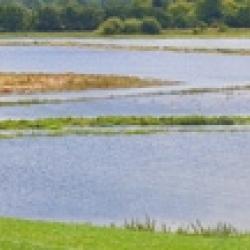Source Institutions
Add to list Go to activity
Activity link broken? See if it's at the internet archive

In this design-based lesson, learners study flood dynamics as they modify a riverbed with blockages or levees to simulate real-world scenarios. Learners will learn about floodplains, consider different manmade and natural factors that contribute to flooding, and explore different structures that can be used to mitigate flood damage.
- 10 to 30 minutes
- 1 to 2 hours
- Over $20 per group of students
- Ages 11 - 14
- Activity, Experiment/Lab Activity, Lesson/Lesson Plan, Model
- English
Quick Guide
Materials List (per group of students)
- 2 sheets of cardstock (or paper) for construction of model houses
- Model House Template
- Transparent tape
- Scissors
- Markers, colored pencils, or crayons to decorate houses
- 5-pound (2.3 kg) box of oil-based modeling clay per group (reusable)
- Aluminum baking pan
- Small board (or something else rigid) to support the baking tin after inserting the clay
- Clean-up supplies (paper towels, sponges, towels, etc.), for after using wet clay
- Thick book to prop up the plastic tub (may not be needed if you conduct activity outside)
- Riverbed Template, one of three designs provided
- Optional: additional cardstock, rulers, protractors, etc.
- Computer with projector and internet access
- Floods, Floodplains and Levees
- 1 large, shallow, plastic waterproof tub, 8-in x 14-in x 30-in or 20-cm x 36-cm x 76-cm, clear plastic is better but not necessary
- Wire cutters or tin snips to cut the baking pan
- Small paper cup, used to pour water over the riverbed model
Subjects
-
Earth and Space Science
-
Earth Processes
- Weather and Climate
-
Earth Structure
- Oceans and Water
-
Earth Processes
-
Engineering and Technology
-
Engineering
- Civil Engineering
- Environmental Engineering
-
Engineering
-
Mathematics
-
Geometry
- Plane Geometry
-
Geometry
-
The Nature of Science
-
Science and Society
- Risks and Benefits
-
The Scientific Process
- Conducting Investigations
-
Science and Society
Informal Categories
- Model Building
- Nature and Environment
- Outdoor Activity
Audience
To use this activity, learners need to:
- see
- read
- touch
Learning styles supported:
- Involves teamwork and communication skills
- Involves hands-on or lab activities
Other
Includes alignment to state and/or national standards:
Includes assesments for student learning:
This resource is part of:
Access Rights:
- Free access
By:
- Nicklas, Tim ; Schaefer Zarske, Malinda ; Ekern, Kristi ; Carlson, Denise
Source Collection
- TeachEngineering
Rights:
- All rights reserved, Regents of the University of Colorado, 2006
Funding Sources:
- Fund for the Improvement of Postsecondary Education (FIPSE)
- U.S. Department of Education
- National Science Foundation, 0338326
